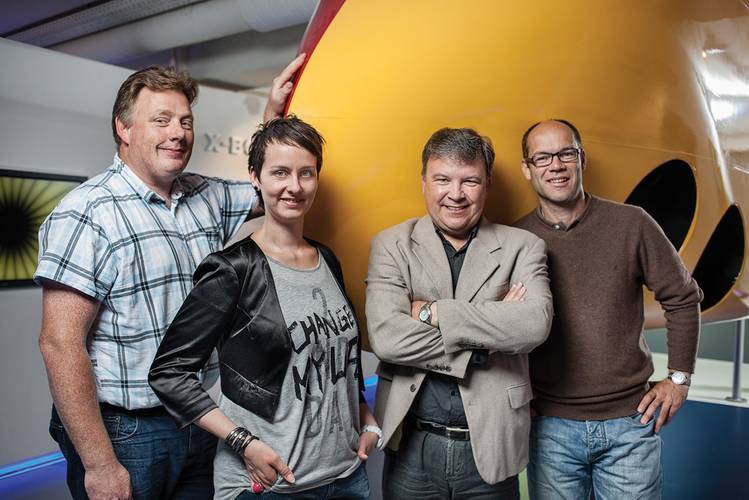Cool Under Pressure in Harsh Environs
GC Rieber Shipping, the Norway-based harsh environment shipping specialist, has charged ULSTEIN with developing a high-capacity subsea vessel based on its SX121 design. This $141m million ship, ordered in June 2012, alongside an option for a sister vessel, has been commissioned in response to strong market desire for offshore construction support vessels (CSVs) for deep and harsh environments. Alongside state-of-the-art features, equipment and performance figures, the vessel will give GC Rieber Shipping maximum operational availability – a vital characteristic for both the company and those chartering the ship. Downtime will be minimised thanks to the ‘operation+’ feature, an evolution of GC Rieber Shipping’s own ‘fail-to-safe’ design approach.
‘Operation+’ allows the vessel to continue to operate even if it has experienced a significant failure. Bjørn Valberg, GC Rieber Shipping’s Technical Director, explains more:
“Fail-to-safe means that even if a ship encounters a failure it is rendered in a safe condition. Our objective with this ship is to take that philosophy a step further,” Valberg comments.
“In the case of this vessel a single failure – such as a failure of a generator set, a single thruster or even an entire switchboard section (operating two generators and two thrusters) – will not threaten the redundant continuation of operations, giving charterers real peace of mind.”
Valberg illustrates this with a real-life scenario involving subsea flex pipe laying – an operation the new vessel is optimised for – where, if a single failure was encountered, a ‘standard’ ship would be forced to terminate operations as redundancy would be jeopardised.
“And of course,” he states, “if you are in deep waters with a substantial length of product, such as flex pipe, hanging from the ship, abandoning that operation is, well… it’s quite obvious how difficult, time-consuming and expensive that is.
“This new vessel, thanks to ‘operation+’ is protected against that scenario – it could continue with its assignment. That’s a hugely important characteristic of that vessel, helping the charterer meet the demanding expectations of the market.”
ULSTEIN’s design and solutions team has been working to turn this concept into reality and deliver the Holy Grail of minimal operational downtime and maximum efficiency and reliability.
Geir Sivertstøl, principal engineer electrical systems at ULSTEIN, says the vessel, equipped with three main thrusters and three side thrusters (for stationkeeping during pipe laying), is fully optimised for carrying out assignments without interruption.
He notes: ”The switchboard system, propellers and diesel motors can be configured in groups of two, three or four. In case of an AUTR operation (i.e. the occurrence of a single major failure), the vessel will only lose one third of its installed power package and propulsion, and will be able to complete the operation with two thirds of its capacity.”
“This,” he stresses, “in combination with the highest standards for dynamic positioning, DYNPOS-AUTRO, will ensure that charterers can look forward to operational standards that are custom made to tackle the world’s harshest - and potentially most resource rich - environments.”
Equipped, flexible, compelling
GC Rieber Shipping’s version of the SX121 (yard number 300 at Ulstein Verft) has been equipped to meet the most diverse requirements, in the most demanding of conditions.
The 130-m long, 25-m wide vessel can accommodate a crew of 130 and cut through deep waters with a top speed of 14.5 knots, while meeting all the latest environmental standards.
She is equipped with a powerful 250 ton AHC (active heave compensated) offshore crane, perfect for lifting and lowering heavy equipment to and from subsea environments. A large cargo deck creates the optimal environment for a variety of operations, ensuring that the vessel is well placed to meet the hugely diverse demands of the offshore construction market. It also offers the ability to carry two ROVs (remotely operated vehicles) — one that will be launched from the starboard side and the other through a moon pool. In addition, the ship has been designed with SURF (subsea umbilical riser and flowline) capabilities and is prepared for the installation of a below-deck basket/ carousel with a 2500 ton capacity, as well as a 250 ton VLS (vertical lay system) for deployment through the moon pool. It is, as Valberg stresses, a compellingly comprehensive package: “One of the main reasons for choosing the SX121 design from ULSTEIN was its inherent flexibility, which allows several types of operations and enables us to operate in a wider range of market segments.
The fact that we can utilize the 250 ton crane to the maximum of its capability both in offshore and subsea lifts on this vessel was another deciding factor.”
GC Rieber Shipping’s vessel is, according to Tore Ulstein, deputy CEO in Ulstein Group, the ‘perfect project’ for ULSTEIN to show its renowned design and shipbuilding pedigree. Tore Ulstein notes that the business is well accustomed to developing and producing vessels that have the capability to minimise operational downtime, maximizing customers’ profits.
He commented: “Our organization has broad expertise in developing advanced high-capacity offshore vessels together with customers, so this project suits us perfectly.” The SX121 is scheduled for delivery in the first quarter of 2014, boosting GC Rieber Shipping’s fleet (which was fully booked at the conclusion of 2011) of 18 advanced special purpose vessels, 12 of which are owned by the company. CEO of GC Rieber Shipping, Irene W. Basili, has imparted that the new addition to the company will “strengthen our position in the high-end subsea segment” and that she is looking forward to receiving “a top-class vessel from ULSTEIN” – a sentiment that potential charterers will no doubt agree with.
www.ulstein.com
(As published in the November 2012 edition of Maritime Reporter - www.marinelink.com)















